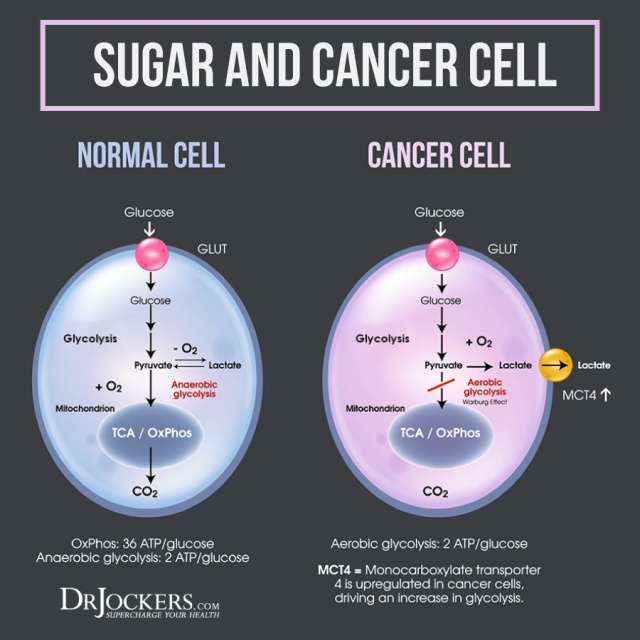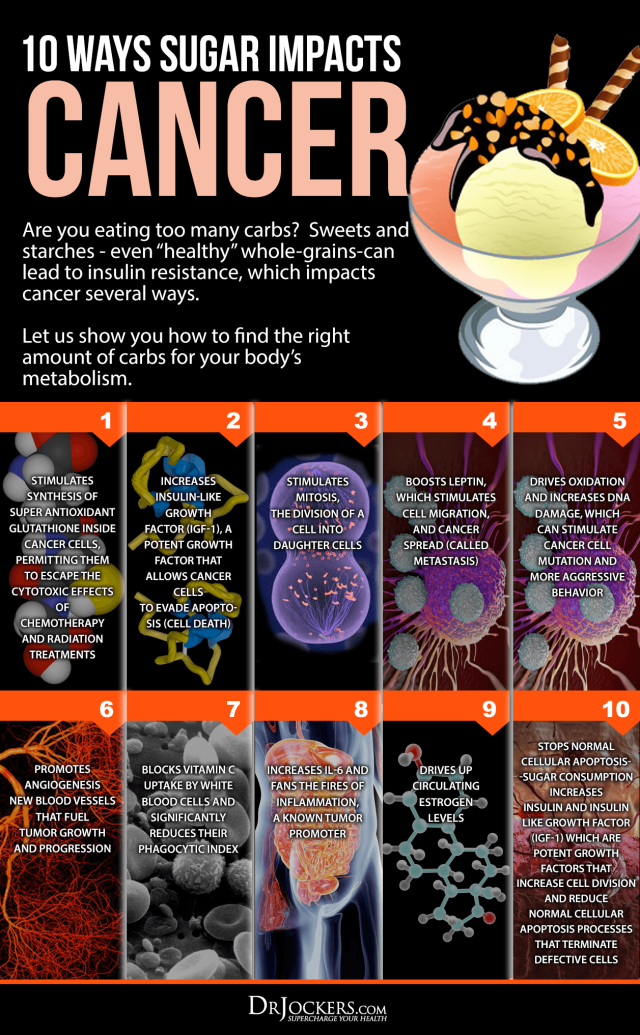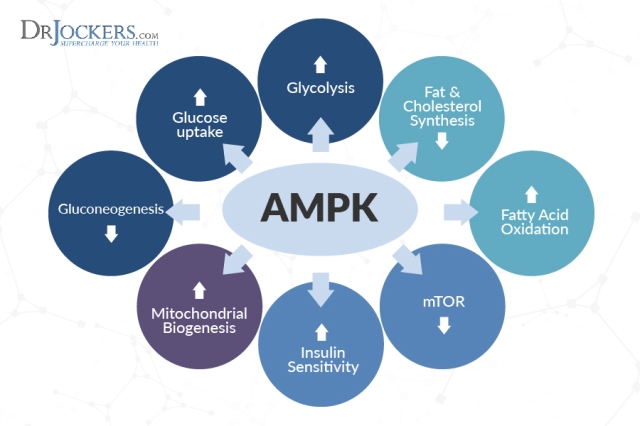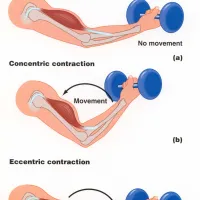Could it be possible that sugar feeds cancer growth? Billions of dollars are funneled into cancer research every year… and still, sugar is a relevant reason for cancer growth that is often forgotten.
Take a look at almost any cancer treatment center in the US that uses the traditional treatment methods (chemotherapy, radiation, and surgery) and you’ll notice something outright blasphemous. To help keep weight on their patients, they offer snacks and meal replacements. The problem? They are loaded with sugar and processed ingredients and… sugar feeds cancer.
When it comes to people who are trying to fight off cancer, consuming low-carb on a regular basis is absolutely vital. Our traditional oncological doctors seem to brush this fact off as a non-factor but if your goal is to give the body a fighting chance against cancer, sugar must go.

Cancer Cells x Healthy Cells
When you are looking at fighting cancer while keeping normal cells healthy, you have to ask yourself, what makes a cancer cell different?
Based on what we know from research, cancer cells are metabolically damaged. Metabolically damaged in that, their energy producing structures e mitochondria, are unable to operate efficiently.
A cancer cell manifests in their preference for glucose as a fuel source, relatively low-yield production of ATP, and rampant production of oxidative species. Normal healthy cells, on the other hand, are able to exhibit metabolic flexibility where they can burn multiple sources of fuel, produce more ATP, and relatively lower levels of oxidative species.

The Mitochondrial Aspect
For a long time, researchers focused on the nuclear genome for the cause of diseases. This is where the whole idea that diseases are hereditary came from. With the rampant up-rise in chronic disease over the last 100 years, the nuclear genome hardly makes sense. Changes in the nuclear genome occur over thousands if not hundreds of thousands of years.
It turns out epigenetic changes occur much more rapidly in the mitochondrial genome and science is catching on to this concept. The healthier your mitochondria are, the healthier you will be. This is a simple byproduct of efficient energy production.
As we look deeper into many of the chronic diseases plaguing us today, we are beginning to notice that the mitochondria play a much larger role than we ever considered.
But How is Energy Formed in a Cell?
Cells need energy to perform normal functions including: responding to their environment, absorbing nutrients, exporting toxins, growing, replicating, etc. This energy Is produced through a process called respiration.
There are two types of respiration: aerobic and anaerobic.
Normal, healthy cells in most cases will use aerobic respiration which occurs in the mitochondria. This process involves breaking glucose down into pyruvate in the cytosol, transporting it to the mitochondria, and forming ATP in the presence of oxygen. Given that there is enough oxygen within the cells, this is the default method of energy production. The byproducts of this process are 36 molecules of ATP and carbon dioxide, which is released through breathing.
When there is a lack of oxygen, anaerobic respiration takes place. This occurs in the cytosol of the cell where glucose is broken down into pyruvate and directly converted into ATP and lactic acid. This process never reaches the mitochondria and only generates 2 molecules of ATP.
While anaerobic respiration produces a tiny fraction of the energy (2 ATP versus 36 ATP), it actually generates ATP at almost 100 times the rate. We know that rapidly dividing tissues, such as healing wounds or cancer, tend to take advantage of anaerobic respiration for quick energy production.
While anaerobic respiration provides energy faster, there may be other factors that make this method of energy production beneficial for growing cancer cells.

Cancer Cell Energy Production
A healthy cell with enough oxygen should perform both glycolysis and oxidative phosphorylation for the production of energy.
Healthy cells can also utilize ketone bodies, converted from fatty acids, to produce ATP through aerobic respiration.
What we now know is that cancer cells, even in the presence of oxygen, choose to undergo glycolysis utilizing glucose (and sometimes glutamine) as the favored substrate. This is the more scientific understanding of how sugar feeds cancer.
This is thought to be due to damaged mitochondrial structures within cancer cells inhibiting the cells ability to undergo aerobic respiration. Glucose enters the cell and is converted into pyruvate within the cytosol but cannot enter the mitochondria to undergo aerobic respiration.
As a result, growing cancer cells upregulate glucose transport proteins on their surfaces in order to take in as much glucose as possible. There is also a rampant build-up of lactic acid in cancer cells as a byproduct of anaerobic respiration. This means as long as it is abundant in the blood, sugar feeds cancer growth in a way that will only promote its development.

Advantages of Glycolysis For Cancer
While some people see glycolysis in cancer cells as a byproduct of damaged mitochondria, it is also possible that cancer cells have adapted to favor glycolysis for its growth promoting properties.Not only does glycolysis produce energy more rapidly that aerobic respiration, but it actually promotes an environment where cancer cells can rapidly divide.
Excess lactic acid produced by cancer cells actually shuts off the body’s anticancer immune response by deactivating anti-tumor immune cells. This essentially shields cancer from the immune system.
At the same time, rapid cell growth requires a lot of raw materials to make new cells. One of the primary atoms needed in abundance to form new cell structures is carbon. Carbon atoms are linked together to form backbones that cell structures are built off of.
After glucose is metabolized, it leaves a 6-carbon chain. While aerobic respiration excretes this carbon through the breath via carbon dioxide, glycolysis retains it. It is thought that this allows for a more rapid division of cells through a higher availability of raw materials.

How Sugar Feeds Cancer Growth
As has been covered so far, cancer cells have an impaired ability to produce energy. Due to damaged mitochondrial structures, they perform glycolysis rather than aerobic respiration. As a result, they must upregulate glucose intake in order to support rapid division and growth.
At the same time glycolysis favors cancer growth in several ways. This why a ketogenic diet has been heavily investigated for being able to limit cancer growth by cutting off its primary fuel supply. In addition to this, there are other mechanisms by which sugar feeds cancer growth.
White Blood Cells
White blood cells are the soldiers of our immune system. They are a powerful force against foreign invaders in our bodies including cancer cells. In order to operate at their full capacity, they require high amounts of Vitamin C. This was discovered by Nobel Prize winner, Linus Pauling, in the 1960’s.
Unlike other animals, humans are not able to produce Vitamin C endogenously. Instead we must receive it from our foods and transport it to our cells for use. We then have internal antioxidant systems that help us to retain and recycle Vitamin C to get the most use out of it. This is a function of glutathione.
In the 1970’s Dr. John Ely discovered what is referred to as the Glucose-Ascorbate-Antagonism (GAA) Theory. Both glucose and Vitamin C are similar in structure and rely upon insulin in order to enter the cells via the Glut-1 receptor on the cell membrane. Unfortunately, glucose has a higher affinity for this receptor which means it is absorbed more readily than vitamin C.
It is thought that having high levels of blood sugar actually inhibits Vitamin C from entering the white blood cells, which drastically reduces immunity and therefore the ability to fight off cancer. So, while sugar feeds cancer, it also inhibits the immune system for acting upon cancer cells.
Phagocytic Index
In order for white blood cells to destroy foreign pathogens within the body, they do so by engulfing them and essentially breaking them down into benign byproducts. This process is called phagocytosis. The measure of how well a white blood cell is able to perform this function is called the phagocytic index.
Therefore, in order to provide the best chance for the immune system to target cancer cells, they need to have a high phagocytic index.
Because of the relationship explained above between glucose and vitamin C, high levels of sugar circulating in the blood is thought to lower the phagocytic index of white blood cells, impairing their ability to fight cancer. In fact, it has been shown that a blood sugar level of 120 actually reduces phagocytic index by 75%.

Sugar Feeds Cancer via Insulin HMP Shunt
In addition to Vitamin C’s importance for proper phagocytic functioning of white blood cells, it is also critical for stimulation of the hexose monophosphate (HMP) pathway.
The HMP pathway produces NADPH which is used by white blood cells to make superoxide and reactive oxygen species that are used to destroy pathogens. This HMP shunt also produces ribose and deoxyribose which provide important raw materials for the formation of new white blood cell RNA/DNA.
When the immune system is under attack it needs to quickly produce new immune cells. If blood sugar is high enough to turn off the HMP shunt it will reduce the quantity of RNA/DNA and the amount of new immune cells formed.

Sugar Feeds Cancer via AMP-K
AMP-K stands for Adenosine Monophosphate-activated protein kinase. When ATP (Adenosine Triphosphate) is broken down for energy within cells, phosphate groups are removed to form ADP and AMP (Adenosine Diphosphate and Adenosine Monophosphate, respectively).
When the ratio of AMP to ATP is increased, it is a sign that energy is getting low and AMP-K signals the upregulation of ATP production. In this manner, AMP-K is an energy regulating molecule.
It has also been shown that upregulation of AMP-K diverts glucose away from cancer cells and towards the body’s healthy tissues (7). In fact, it is suggested that activation of AMP-K helps to reverse the glycolytic preference of cancer cells, giving them an energetic disadvantage.
Luckily, AMP-K activity can be upregulated by intense exercise, carbohydrate restriction, and intermittent fasting.
There are a number of peripheral benefits of AMP-K activation that are centered around key physiological pathways that are also associated with cancer growth. These include mTOR, the p53 gene, and COX-2 enzymes.

Sugar Feeds Cancer via mTOR
Sugar feeds cancer another way by activating biological growth pathways in the body, namely mTOR. mTOR (mammalian target of rapamycin) is a physiological pathway that regulates cell growth and replication. We know that cancer tissues have an elevated expression of mTOR signaling that may contribute to rapid cell growth in cancer.
Upregulation of AMP-K through the strategies listed in the previous section have actually been shown to inhibit this mechanism of cancer growth.
While mTOR is necessary for a healthy body, having a chronically activated mTOR pathway is what contributes to cancer development. Consequently, one of the primary activators of the mTOR pathway is insulin. Naturally, chronic sugar consumption will leave insulin levels high which will contribute to constantly elevated mTOR.
This is yet another way lowering dietary glucose, fasting, and a ketogenic diet may be able to help the body combat cancer.
By combining these techniques, blood sugar becomes stable, insulin drops, and these growth pathways become less of a contributing factor towards cancer growth.
Sugar Feeds Cancer via The p53 Gene
The p53 gene is responsible for controlling tumor development by responding to damaged DNA sequences and regulating gene expression in cancerous tissues.
If the DNA is able to be repaired, the p53 gene will allow the cell to go back into its normal cycle of growth and reproduction. If the DNA cannot be repaired, then p53 signals for cellular apoptosis (programmed cell death). It has been found that the p53 gene is inactivated in a large proportion of cancers, making it a pharmacological target in cancer treatment.
Yet another benefit of AMP-K activation is that it actually improves p53 expression and prevents it from becoming inactive in the first place. This occurs because AMP-K phosphorylates p53 and, in turn, makes it more stable.
Among many others, high blood sugar is recognized as a contributing factor for inactive or mutation of p53 genes as well. This may be due to hyperglycemia inhibiting the absorption of zinc, which is supposed to bind to p53 to activate it.
Sugar Feeds Cancer via COX-2 Enzymes
COX-2 is an abbreviated version of Cyclooxygenase-2. COX-2 is a pro-inflammatory enzyme that is elevated in many cancers and is thought to contribute to the aggressiveness of tumors.
The COX-2 enzyme is yet another pharmacological target that many cancer therapies attempt to take advantage of. Rightfully so, lowering this inflammatory enzyme may have powerful potential in a holistic approach to healing cancer. While more research is needed in the area, activation of AMP-K has also been associated with COX-2 inhibition.
Sugar Feeds Cancer, Fat Doesn’t
Given what we have covered so far, there seems to be a logical solution to placing cancer cells at a metabolic disadvantage. Given that cancer cells are highly glycolytic and thrive in an acidic environment, steps should be taken to ensure that the availability of glucose is very low in the blood stream.
Additionally, upregulating AMP-K and driving aerobic metabolism towards the oxidation of fatty acids over glucose can be very powerful. Following the strategies below will help you improve AMP-K and convert over to burning fat for fuel.

Reduce Sugar
Of course, we understand by now that sugar feeds cancer and so it is imperative that sugar and highly insulinogenic carbohydrate sources be removed from the diet. Insulin is a significant promoter of cancer cell growth and it must be limited as best as possible.
This means relying on healthy fats as the primary source of calories and only moderate amounts of clean protein. Overconsumption of protein can become gluconeogenic, meaning the body begins to convert proteins into glucose.
Cancer cells have an abnormally high number of insulin receptors and extremely upregulated glucose metabolism. This means that depending on the severity of your cancer development, cancer cells are stealing sugar that should be going to your healthy cells. This means sugar feeds cancer at the expense of the rest of your healthy cells while ketones provide an interesting shift in the opposite direction.
Ketogenic Diet
While removing sugars and carbs is a great first step, it can be equally as important to implement a ketogenic diet. This is where you train your healthy cells to burn ketones, made from fat, as energy instead of glucose.
This is important because, as I just mentioned, aggressive cancer cells will essentially steal glucose away from healthy cells. This feeds the cancer cells while leaving your healthy cells in a weakened state, lose-lose.
Most cancer cells cannot utilize ketones as a fuel source. So, by teaching your healthy cells to do so, you help return vitality to your healthy cells while weakening your cancer cells, win-win. You reduce the sugar feeds cancer phenomenon.
Reducing Sugar Cravings
Because cancer cells are stealing glucose from your healthy cells, your healthy cells will have less glucose to create fuel. As a result, your brain will be receiving signals that you need more, which will likely trigger carbohydrate cravings.
These will likely become even more pronounce in the beginning stages of implementing a ketogenic diet because many cancer patients have weakened mitochondria. Using strategies to stimulate mitochondria and allow the body to begin making ketones more quickly can help a lot here. This is where exogenous ketones or MCT oils containing C8 and C10 fatty acids can help.
Once ketone production becomes efficient, these cravings will likely diminish greatly. Other strategies to help reduce these cravings include exercise, staying hydrated, getting plenty of minerals, supporting the HPA axis, and supporting optimal dopamine production.
Intermittent Fasting
In addition to following a ketogenic diet, intermittent fasting is a powerful strategy to quickly reduce insulin and upregulate AMP-K activity. At the same time, intermittent fasting strengthens the immune system to help your white blood cells seek out and destroy cancer cells.
As if those benefits weren’t powerful enough, fasting also upregulates cellular autophagy (breaking down of damaged and abnormal cells) and genetic repair. So, we get rid of bad cells and repair the rest. This benefit becomes more powerful during longer bouts of fasting (24 hours or more).
Finally, intermittent fasting improves your metabolic flexibility to help you get into a deeper state of ketosis at a much quicker rate. At this point, I would say that is a win-win-win-win-win-win… You get what I mean.
Start with a 12-hour fasting window where you consume nothing but water or non-caloric herbal teas for a 12-hours window between dinner and breakfast the next day. Once your body tolerates this well, work up to a longer fast as outlined below.
Other Critical Ketogenic Diet Tips
So, we know that sugar feeds cancer, but there are other strategies to boost your success when on a cancer healing journey. In addition to the strategies outlined above, there a few other ways to ensure you are optimizing your health on a ketogenic diet.
Super Hydration
While in a fasted state, it is a great time to drink plenty of water to ensure proper hydration and to assist with gentle detoxification. It is extremely important that you get pure water with no chlorine or fluoride in it.
I recommend super hydrating your system by drinking 32 oz. of water within the first hour of waking and another 32-48 oz. of water before noon. Additionally, you should aim to consume close to your full body weight in ounces of water each day. So a 150 lb person can aim to drink 150 ounces of water in the form of water, herbal teas, lemon water, broth, etc.
This amount of water seems excessive, but as long as it comes with enough minerals (adding in a pinch of good salt), it is extremely cleansing to the body. In addition, staying hydrated will improve your energy and reduce feelings of hunger or cravings.

High Quality Salts
Most people in society avoid salts as they have been taught that excess sodium contributes to high blood pressure. However, during the initial adaptation phase to a ketogenic diet, the body excretes excess sodium and minerals due to a drop in insulin levels.
If you don’t replace these minerals, you can end up with many of the symptoms of the keto flu. Be sure to replenish these minerals by using a high-quality pink or gray salt and drinking organic bone broth throughout the day.

Get Regular Exercise
Short bursts of intense exercise increase AMP-K and promote metabolic flexibility while increasing oxygenation of tissues. Be sure to keep it to 15-20 minutes 2-4 times a week, overdoing it can raise cortisol and pull you out of ketosis.
Additionally, get regular low intensity exercise such as barefoot walking outdoors. This adds the benefit of free electrons from the Earth that are helpful for your electromagnetic frequency, which calms your stress response and improves healing and sense of well-being.

Improve Bowel Movements
Many people don’t consider this as an important factor but constipation can drive up stress hormones and pull you out of ketosis. Many people experience constipation on a ketogenic diet so it is important to take steps to mitigate this.
You should be sure to consume plenty of fibrous vegetables, fermented foods, water, minerals, and never eat in a stressed state. Stress inhibits digestion so be sure to perform an act of gratitude or prayer before meals to help pull your body into a resting state.
If intestinal bacterial overgrowth is an issue, this should absolutely be addressed as another cause of poor digestion. Finally, magnesium supplementation can be a great remedy for constipation while also supporting the body for optimal health overall.

Control Protein Intake
Eating too much protein can easily stimulate gluconeogenesis which will raise blood sugar and pull you out of ketosis. Most individuals will want to aim for 0.4-0.5 grams of protein per pound of bodyweight and around 20-30 grams per meal.
This means a 150 lb. individual would only need about 60-75 grams of protein each day. Individuals who are more active and involved in intense weight training or intense athletic endeavors may go up to 0.6-0.7 grams of protein per pound of body weight on heavy training days.
Use MCT Oil
Producing ketones can be a stressor on the body, especially if you have mitochondrial dysfunction. MCT oil is easily converted into ketones to relieve some of this stress and improve your state of ketosis. Avoid brands that contain lauric acid (C12) as this fatty acid is not easily converted into ketones.
I often recommend the Keto Brain MCT oil which contains pure C8 MCT oil which converts into ketones most efficiently.
Improve Your Sleep
Mitigating stress is a key aspect of maintaining an optimal state of ketosis and getting good sleep is a paramount aspect of this. Poor sleep is consistently correlated with blood sugar imbalance and increased risk of cancer. A good start is to be in bed no later than 11pm, make sure the room is completely blacked out, and lower the temperature to about 60-65 degrees.
More advanced strategies for optimal sleep include:
Getting AM sunlight to prime the circadian rhythm
Avoiding blue light exposure within 4 hours of sleep by investing in a pair of blue-light blocking glasses
Developing a relaxing routine that you go through every night before bed. This could include prayer, meditation, gratitude journaling, light stretching, or anything that brings you peace and comfort.
Conclusion
We know a lot about how cancer cells behave and what conditions allow them to thrive. Because of this, we are able to alter our internal environment in order to favor our healthy cells over cancer cells.
We understand how sugar feeds cancer. Therefore, reducing sugar intake, getting the body into a state of ketosis and implementing intermittent fasting can be powerful cancer-fighting strategies. Because cancer cells in general are metabolically inflexible, we are able to take advantage of ketone metabolism as a way of placing cancer cells in a weakened state.
Not only does this make these strategies powerful stand-alone healing practices, but also for improving the outcomes of traditional treatments. Armed with the knowledge of how sugar feeds cancer, you will be empowered to move forward with your healing journey that you see beneficial for you.






Pingback: Common Foods that will Trigger Anxiety | vick physiotherapy international
Pingback: Any joint pain after COVID-19 infection? Why could that happen? | vick physiotherapy international
Pingback: GUT Health and triggers for Brain Health | vick physiotherapy international